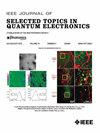White Gaussian Noise Generation With a Vacuum State Quantum Entropy Source Chip
IF 5.1
2区 工程技术
Q1 ENGINEERING, ELECTRICAL & ELECTRONIC
IEEE Journal of Selected Topics in Quantum Electronics
Pub Date : 2025-03-04
DOI:10.1109/JSTQE.2025.3547839
引用次数: 0
Abstract
White Gaussian noise (WGN) is widely used in communication system testing, physical modeling, Monte Carlo simulations, and electronic countermeasures. WGN generation relies heavily on random numbers. In this work, we present an implementation of WGN generation utilizing a quantum entropy source chip for the first time. A photonic integrated chip based on the vacuum state scheme generates quantum random numbers at a real-time output rate of up to 6.4 Gbps. A hardware-based inversion method converts uniform quantum random numbers into Gaussian random numbers using the inverse cumulative distribution function. Subsequently, the WGN signal is generated through a digital-to-analog converter and amplifiers. The WGN generator is characterized by a bandwidth of 230 MHz, a crest factor as high as 6.2, and an adjustable peak-to-peak range of 2.5 V. This work introduces a novel approach to WGN generation with information-theory provable quantum random numbers to enhance system security.利用真空态量子熵源芯片产生高斯白噪声
高斯白噪声(WGN)广泛应用于通信系统测试、物理建模、蒙特卡罗仿真和电子对抗等领域。WGN的生成严重依赖于随机数。在这项工作中,我们首次利用量子熵源芯片实现了WGN的生成。基于真空态方案的光子集成芯片以高达6.4 Gbps的实时输出速率生成量子随机数。一种基于硬件的反演方法利用逆累积分布函数将均匀量子随机数转换为高斯随机数。随后,通过数模转换器和放大器产生WGN信号。WGN发生器的特点是带宽为230 MHz,波峰系数高达6.2,峰值到峰值范围可调为2.5 V。本文介绍了一种利用信息论可证明量子随机数生成WGN的新方法,以提高系统的安全性。
本文章由计算机程序翻译,如有差异,请以英文原文为准。
求助全文
约1分钟内获得全文
求助全文
来源期刊

IEEE Journal of Selected Topics in Quantum Electronics
工程技术-工程:电子与电气
CiteScore
10.60
自引率
2.00%
发文量
212
审稿时长
3 months
期刊介绍:
Papers published in the IEEE Journal of Selected Topics in Quantum Electronics fall within the broad field of science and technology of quantum electronics of a device, subsystem, or system-oriented nature. Each issue is devoted to a specific topic within this broad spectrum. Announcements of the topical areas planned for future issues, along with deadlines for receipt of manuscripts, are published in this Journal and in the IEEE Journal of Quantum Electronics. Generally, the scope of manuscripts appropriate to this Journal is the same as that for the IEEE Journal of Quantum Electronics. Manuscripts are published that report original theoretical and/or experimental research results that advance the scientific and technological base of quantum electronics devices, systems, or applications. The Journal is dedicated toward publishing research results that advance the state of the art or add to the understanding of the generation, amplification, modulation, detection, waveguiding, or propagation characteristics of coherent electromagnetic radiation having sub-millimeter and shorter wavelengths. In order to be suitable for publication in this Journal, the content of manuscripts concerned with subject-related research must have a potential impact on advancing the technological base of quantum electronic devices, systems, and/or applications. Potential authors of subject-related research have the responsibility of pointing out this potential impact. System-oriented manuscripts must be concerned with systems that perform a function previously unavailable or that outperform previously established systems that did not use quantum electronic components or concepts. Tutorial and review papers are by invitation only.
 求助内容:
求助内容: 应助结果提醒方式:
应助结果提醒方式:


